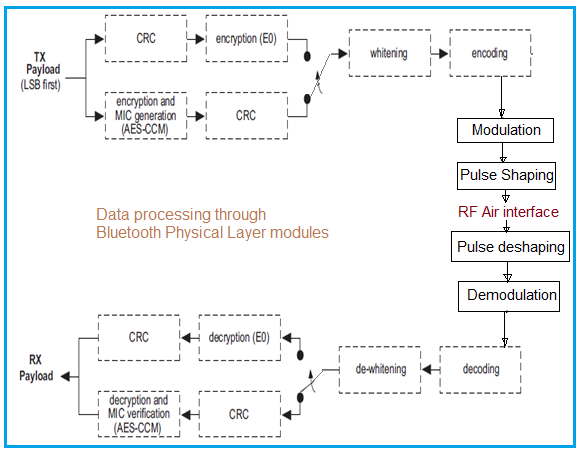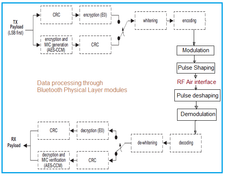Bluetooth Physical Layer: Header and Data Payload Processing
Advertisement
This article explains the Bluetooth physical layer modules and how Bluetooth packet headers and data payloads are processed.
Introduction:
Bluetooth technology specifications are developed and maintained by the Bluetooth SIG (Special Interest Group). There have been numerous Bluetooth versions, from V1.2 to V4.1, V4.2, V5.0, and the recently published V5.1. Bluetooth devices operate in the 2.4 GHz unlicensed frequency band.
This band is divided into 40 channels, with 3 dedicated to advertising and 37 used for data transmission/reception. Bluetooth devices typically communicate within a range of about 50 meters indoors and 150 meters outdoors. Bluetooth networks can be arranged in two topologies: piconets and scatternets.
A piconet consists of one master and one or more slaves. A scatternet is a combination of multiple piconets. A device can participate in multiple piconets through timesharing, synchronizing with the master of the current piconet.

The figure above illustrates the Bluetooth protocol stack and its different layers. Layer 1 is the physical layer or baseband layer. Download and read “Bluetooth protocol stack documentation” for details on each layer’s functions.
Bluetooth Packet Format
The Bluetooth packet structure is shown below. It includes a preamble (1 byte), access address (4 bytes), PDU (maximum 257 bytes), and CRC (3 bytes). The PDU carries either an advertising packet or a data packet, both of which have a header and a payload.

The header (2 bytes) and payload (maximum 37 bytes in an advertising packet and 255 bytes in a data packet) are processed separately by Bluetooth physical layer modules.

The packet structure for BR (Basic Rate) and EDR (Enhanced Data Rate) is shown in the figure.
Header Processing Through Bluetooth Physical Layer

The following section describes the header processing within the Bluetooth physical layer:
(Transmitter Part:)
- HEC (Header Error Check) is generated and added to the packet header.
- Header bits are scrambled using a whitening word.
- FEC (Forward Error Correction) encoding is applied to the scrambled data bits.
- FEC-encoded data bits are modulated.
- Pulse shaping is applied before RF up-conversion.
- The pulse-shaped data is up-converted to 2.4 GHz and transmitted over the air.
(Receiver Part:)
- The reverse operations are performed at the Bluetooth receiver: RF down-conversion, pulse de-shaping, demodulation, FEC decoding, de-whitening, and HEC checking before the header is decoded.
Data Payload Processing Through Bluetooth Physical Layer

The following section describes data payload processing within the Bluetooth physical layer:
The payload processing utilizes all the modules used for header processing. Additionally, it uses an encryption module, either E0 or AES-CCM. When E0 encryption is used, the entire payload is encrypted. When AES-CCM encryption is used, only the payload body and MIC (Message Integrity Code) are encrypted; the payload header and CRC remain unencrypted.
The transmitter and receiver parts of the Bluetooth physical layer processing are self-explanatory, as shown in the figure.
Bluetooth Physical Layer Modules or Blocks
The following section provides a brief overview of the Bluetooth physical layer modules or blocks. For detailed specifications, read Bluetooth Specification Vol-2, Part-B, published by the Bluetooth SIG.
- Error Checking: HEC generation and checking, as well as CRC generation, are defined in the standard with their respective generator polynomials.
- Data Whitening: Data whitening should not be applied to synchronization train packets. Both the header and payload are scrambled with a data whitening word to randomize the data and minimize DC bias before FEC encoding. The whitening word is generated with the polynomial g(D) = D7 + D4 + 1, which is 221 in octal representation.
- Error Correction: Bluetooth uses three error correction schemes: 1/3 rate FEC, 2/3 rate FEC, and ARQ (Automatic Repeat Request). With ARQ, different packet types are transmitted until an acknowledgment of successful reception is returned or a timeout occurs.
- Modulation: There are two main modulation modes: basic rate and enhanced data rate. Binary FM modulation is used for the basic rate, while PSK modulation is used for the enhanced data rate. PSK has two variants: π/4-DQPSK and 8-DPSK. Binary FM modulation is also known as GFSK (Gaussian Frequency Shift Keying). The symbol rate is the same for all three modulation types (1 MSym/Sec). Different gross data rates are achievable: 1 Mbps (basic rate), 2 Mbps (EDR using π/4-DQPSK), and 3 Mbps (EDR using 8-DPSK). GFSK is used for transmitting the access code and packet header. PSK modulation with a data rate of 2 Mbps or 3 Mbps is used for transmitting the sync sequence, payload, and trailer sequence.
- Pulse Shaping: Square-root raised cosine pulse shaping is applied to generate the equivalent low-pass information-bearing signal v(t).
- RF Frequency Conversion: The pulse-shaped data signal is up-converted according to the ISM band carrier frequency (2.4 GHz) out of the 40 assigned Bluetooth frequency channels, depending on whether it is an advertising or data channel. Adaptive frequency hopping is applied as defined in Vol-2, Part-C, Section 4.1.4.
References:
Bluetooth physical layer (i.e., Bluetooth baseband layer, Layer-1) specifications are defined in Bluetooth Core Document Vol-2, Part-B, Section 7.
Advertisement
 RF
RF

